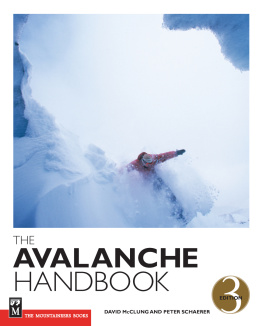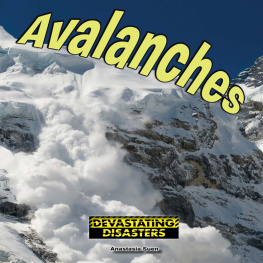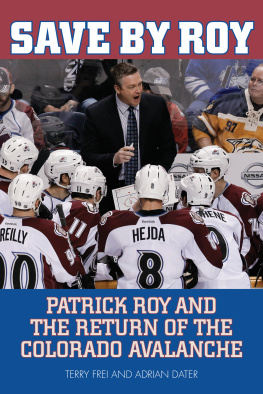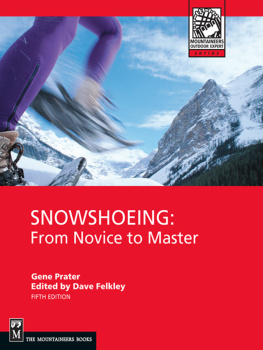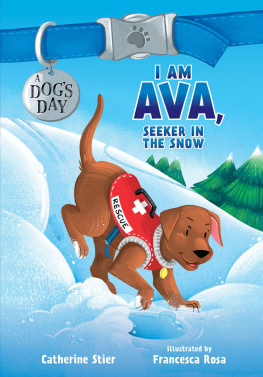THE
AVALANCHE
HANDBOOK
Perhaps the definitive book on snow science and avalanche mechanics The authors credentials are impeccable.
Off Piste
The revised third edition of The Avalanche Handbook could well save your life
Pittsburgh Tribune
This book has been the bible for avalanche workers since the first edition came out in 1953 If you ever start to feel cocky about your avalanche forecasting skills, sit down with this gem and I will guarantee that you will learn something new.
Backcountry Magazine
The Avalanche Handbook is the uber text in the field of avalanche science.
Outside Bozeman
THE
AVALANCHE
HANDBOOK

DAVID McCLUNG AND PETER SCHAERER

 | THE MOUNTAINEERS BOOKS
is the nonprofit publishing arm of The Mountaineers, an organization founded in 1906 and dedicated to the exploration, preservation, and enjoyment of outdoor and wilderness areas.. |
1001 SW Klickitat Way, Suite 201, Seattle, WA 98134
2006 by David McClung and Peter Schaerer
All rights reserved
First edition 1976. Second edition 1993. Third edition: first printing 2006, second printing 2007, third printing 2008, fourth printing 2009, fifth printing 2011
No part of this book may be reproduced in any form, or by any electronic, mechanical, or other means, without permission in writing from the publisher.
Distributed in the United Kingdom by Cordee, www.cordee.co.uk
Manufactured in the United States of America
Project Editor: Christine Ummel Hosler
Copy Editor: Liz McGehee
Cover, Book Design, and Layout: Mayumi Thompson
Illustrator: Blue Mammoth Design
Cover photograph: A snowboarder carves through powder below cornice Jeff Curtes/Getty Images
Back cover photograph: Avalanche descending to the right of the main climbing route on Broad Peak, Karakorum, Pakistan. (Photo: SLF archives)
Library of Congress Cataloging-in-Publication Data
McClung, David.
The Avalanche handbook / David McClung and Peter Schaerer.3rd ed.
p. cm.
Includes bibliographical references.
ISBN 0-89886-809-2
1. AvalanchesHandbooks, manuals, etc. I. Schaerer, P. A. (Peter A.)
II. Title.

QC929.A8M39 2006
551.57'848dc22
2006020817
ISBN 13: 978-0-89886-809-8
FOREWORD
The sequence of North American avalanche manuals over the past fifty-eight years, culminating in this present revised edition of The Avalanche Handbook, is a concise outline of the stages of development in avalanche science and practice during this time.
The pioneer period began when Monty Atwater assumed the position of snow ranger at Alta, Utah, immediately after World War II. With almost nothing in the way of prior information to guide him, Atwater used his keen observation skills and shrewd insights to lay the basis for avalanche forecasting and control. His earliest results appeared in 1948 as Alta Avalanche Studies, written by Monty Atwater and Felix Koziol. Further rapid advances led to the earliest US Forest Service training programs and the need for a more comprehensive manual, which appeared in 1952 as the Forest Service Avalanche Handbook.
The 1950s were the Golden Age of Forest Service avalanche studies. During this time, researchers systematically developed basic techniques of avalanche control. Using an extensive series of tests, they examined the effects of explosives on snow and tested a variety of hand charges and artillery weapons. By 1960 the techniques of control, the size of hand charges, and the most effective weapons had been identified, establishing the control methods still in use today. Drawing on Swiss techniques, researchers introduced the methods of snow pit analysis and time profiles, which became a routine part of snow observations. The Alta Avalanche School reached its heyday with expanded training programs and the preparation of instructional material and films. The Forest Service selected and designed new ski areas nationwide, using the knowledge they gained at Alta. Systematic observation programs at Stevens Pass in the Washington Cascades and at Berthoud Pass in the Colorado Rockies expanded the application of avalanche forecasting and control principles to other climates. When Atwater was assigned to apply all the developing knowledge at the 1960 Squaw Valley Winter Olympics, it fell to me to summarize the progress in the 1961 publication of USDA Handbook 194, Snow Avalanches.
During the next fifteen years, avalanche work came of age in North America. The Alta research, long a stepchild of administrative studies, was transferred as a formal part of USFS research to the Rocky Mountain Experiment Station, and the Alta station was closed. In Canada, development of a major forecasting and control program at Rogers Pass launched considerable activity in avalanches. In the US, the National Avalanche School took over from the Alta training program. The Forest Service delegated much of the routine forecasting and control work in ski areas to an emerging cadre of trained professional patrolmen. The Avalauncher air cannon was developed as a supplement to military weapons for control work. North American researchers played an increasing role in international affairs with participation in scientific conferences and research programs in Japan and Europe, while Handbook 194 was translated into foreign languages. In 1976 (with revisions in 1978), Ronald Perla and M. Martinelli, Jr. of the Rocky Mountain Station brought out a major update and expansion of 194 under the resurrected title Avalanche Handbook, this time USDA Handbook 489, which remained the basic reference for the next seventeen years.
In the 1980s the US Forest Service research program was phased out. Such work continued in Canada, where both federal and provincial support contributed to gains in science and engineering. In 1993 a shift away from the USDA Handbook format brought an international flavor when leading Canadian researchers Peter Schaerer and David McClung undertook a major update of The Avalanche Handbook, with publication taken over by The Mountaineers Books in Seattle. Their work reflected a flowering of mature and sophisticated activity in avalanche affairs. Central forecasting offices had been established in Western states, supported by a network of field observers, remote-sensing instruments, and computerized data processing. Research and field operations reached new levels of sophistication under a new generation of investigators with advanced degrees and well-honed mathematical skills. Avalanche forecasting had advanced with new insights and analyses, supported by increasingly effective models of quantitative mountain precipitation forecasts.
During this period the profession was united under the Canadian Avalanche Association and the American Association of Avalanche Professionals (later American Avalanche Association). Publications of these two organizations, respectively

